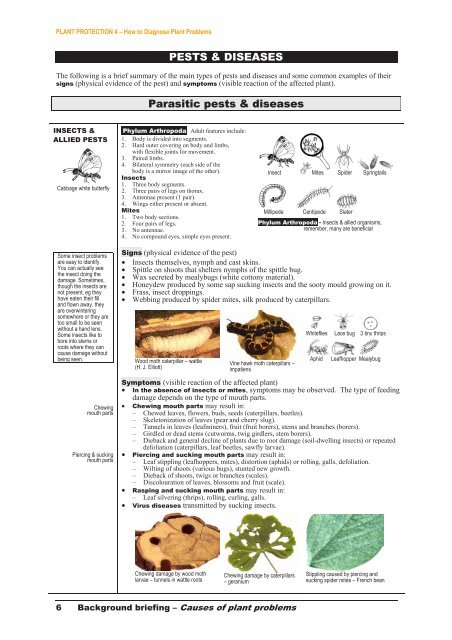PLANT PROTECTION 4
PLANT PROTECTION 4
PLANT PROTECTION 4
Create successful ePaper yourself
Turn your PDF publications into a flip-book with our unique Google optimized e-Paper software.
<strong>PLANT</strong> <strong>PROTECTION</strong> 4 – How to Diagnose Plant Problems<br />
PESTS & DISEASES<br />
The following is a brief summary of the main types of pests and diseases and some common examples of their<br />
signs (physical evidence of the pest) and symptoms (visible reaction of the affected plant).<br />
INSECTS &<br />
ALLIED PESTS<br />
Cabbage white butterfly<br />
Some insect problems<br />
are easy to identify.<br />
You can actually see<br />
the insect doing the<br />
damage. Sometimes,<br />
though the insects are<br />
not present, eg they<br />
have eaten their fill<br />
and flown away, they<br />
are overwintering<br />
somewhere or they are<br />
too small to be seen<br />
without a hand lens.<br />
Some insects like to<br />
bore into stems or<br />
roots where they can<br />
cause damage without<br />
being seen.<br />
Chewing<br />
mouth parts<br />
Piercing & sucking<br />
mouth parts<br />
Parasitic pests & diseases<br />
Phylum Arthropoda. Adult features include:<br />
1. Body is divided into segments.<br />
2. Hard outer covering on body and limbs,<br />
with flexible joints for movement.<br />
3. Paired limbs.<br />
4. Bilateral symmetry (each side of the<br />
body is a mirror image of the other).<br />
Insects<br />
1. Three body segments.<br />
2. Three pairs of legs on thorax.<br />
3. Antennae present (1 pair).<br />
4. Wings either present or absent.<br />
Mites<br />
1. Two body sections.<br />
2. Four pairs of legs.<br />
3. No antennae.<br />
4. No compound eyes, simple eyes present.<br />
6 Background briefing – Causes of plant problems<br />
Insect Mites Spider Springtails<br />
Millipede Centipede Slater<br />
Phylum Arthropoda - Insects & allied organisms,<br />
remember, many are beneficial<br />
Signs (physical evidence of the pest)<br />
Insects themselves, nymph and cast skins.<br />
Spittle on shoots that shelters nymphs of the spittle bug.<br />
Wax secreted by mealybugs (white cottony material).<br />
Honeydew produced by some sap sucking insects and the sooty mould growing on it.<br />
Frass, insect droppings.<br />
Webbing produced by spider mites, silk produced by caterpillars.<br />
Wood moth caterpillar – wattle<br />
(H. J. Elliott)<br />
Vine hawk moth caterpillars –<br />
impatiens<br />
Whiteflies Lace bug 3 tiny thrips<br />
Aphid Leafhopper Mealybug<br />
Symptoms (visible reaction of the affected plant)<br />
In the absence of insects or mites, symptoms may be observed. The type of feeding<br />
damage depends on the type of mouth parts.<br />
Chewing mouth parts may result in:<br />
– Chewed leaves, flowers, buds, seeds (caterpillars, beetles).<br />
– Skeletonization of leaves (pear and cherry slug).<br />
– Tunnels in leaves (leafminers), fruit (fruit borers), stems and branches (borers).<br />
– Girdled or dead stems (cutworms, twig girdlers, stem borers).<br />
– Dieback and general decline of plants due to root damage (soil-dwelling insects) or repeated<br />
defoliation (caterpillars, leaf beetles, sawfly larvae).<br />
Piercing and sucking mouth parts may result in:<br />
– Leaf stippling (leafhoppers, mites), distortion (aphids) or rolling, galls, defoliation.<br />
– Wilting of shoots (various bugs), stunted new growth.<br />
– Dieback of shoots, twigs or branches (scales).<br />
– Discolouration of leaves, blossoms and fruit (scale).<br />
Rasping and sucking mouth parts may result in:<br />
– Leaf silvering (thrips), rolling, curling, galls.<br />
Virus diseases transmitted by sucking insects.<br />
Chewing damage by wood moth<br />
larvae – tunnels in wattle roots<br />
Chewing damage by caterpillars<br />
– geranium<br />
Stippling caused by piercing and<br />
sucking spider mites – French bean






![[Compatibility Mode].pdf](https://img.yumpu.com/27318716/1/190x135/compatibility-modepdf.jpg?quality=85)










